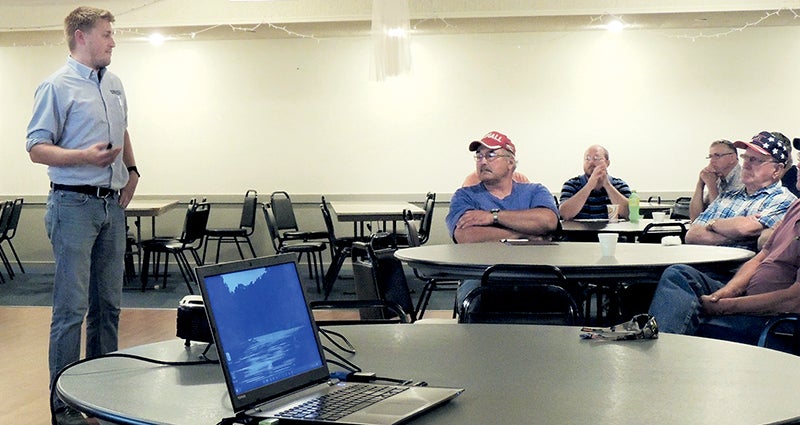Momentum builds for buffers in Mower County
Published 10:31 am Thursday, December 29, 2016

- Aaron Gamm, the buffer coordinator for Mower County Soil & Water, speaks to area farmers this summer at a regional buffer meeting in Blooming Prairie. Photo provided
Justin Hanson
Fields Rivers and Streams
In 2015, Minnesota Gov. Mark Dayton pushed a clean water initiative to the front line of his legislative priority list, with a statewide buffer law as a key component.
In doing that, the term “buffer” became a word that instigated strong reactions everywhere. We’ve been talking about it ever since.
As I look back on the last couple of years, 2015 was a tough one for Mower Soil & Water Conservation District and our discussions with our landowners and producers. The ag economy had turned sour, and there was a great deal of uncertainty about how the new buffer law was going to affect our ag partners locally.
This 2016 year, however, was a different story. The buffer law charged our Mower SWCD office with doing mapping to create an inventory of Mower County’s local buffer needs. This effort resulted in discovering Mower County already was about 94 percent in compliance with the 50-foot buffer requirements.
This was a great reflection on the voluntary compliance steps already taken by local farmers and ag landowners. As staff, we know our local ag partners are leaders in the state for conservation efforts. In recognition of this, we worked this year with several farmers to become certified under the Minnesota Agricultural Water Quality Certification Program.
Ag Certainty is a new program by the Minnesota Department of Agriculture to formally recognize ag producers for doing the right things for water quality. We hope to work with many more in the upcoming year as we’ve found that most of our local producers are meeting that certified standard or very close.
Out of the perceived negativity surrounding the state buffer law, we have gained great knowledge about our local land stewards. Given Mower County’s land ethics, Mower SWCD has been asked by the Minnesota Soybean Growers Association to work with local ag leaders on the alternative practices discussion — what practices can exempt someone from the buffer law — and draft guidance recommendations to the state.
Mower SWCD staff and local landowners have spent the last several months working with scientists from Soybean Growers to develop the methods and standards for alternative practices. We had great cooperation and input from local landowners doing the right things and implementing land practices. Some were actually more beneficial than 50-foot buffers.
This is a process that is not replicated on every site but our farmers told the governor there were other practices that provided more benefit than buffers. Now we have science and examples to back that up.
As we leave 2016, I want to recognize our ag folks for their leadership in conservation. The negative effects of the buffer law are not going to be felt as strongly in Mower County compared to other parts of the state. We asked landowners to come in quickly and take advantage of federal conservation programs that would assist in the buffer establishment. Our ag community responded by flooding the office with CRP signups this past year.
We’ve made great strides towards that 100-percent compliance goal. As we enter 2017, there is a compliance date looming. The buffer law takes effect on November 1st, 2017, for public waterways. If buffers are not in place by that time, landowners will be deemed as out of compliance. There is still much work to do but Mower SWCD is committed to working with our landowners to address buffer needs before compliance deadline.
Mower County also has committed funding to match state funds that enables Mower SWCD to direct additional staff toward the buffer-assistance work.
Here is how Mower SWCD is going to help:
•Use our map set of areas that might need buffers to connect with each of those landowners and provide guidance in the form of a letter.
•Provide technical assistance with maps, measurements, staking or assisting with program options.
•Give landowners with compliance documentation for their records.
•Provide assistance and guidance for farmers to enroll in the state’s Ag Certainty program.
•Offer technical assistance with a variety of buffer needs.
•Review options for alternative practices.
•Visit sites for precision planning layout.
•Stake and measure sites.
•Program guidance and options.
We hope we can use this experience as a positive reflection in the land stewardship of Mower County landowners. We’re challenging ourselves to meet the needs and provide the assistance required to reach 100-percent compliance in 2017.
Aaron Gamm is the Mower County buffer coordinator who will contact landowners soon with further guidance, next steps and landowner options. For questions, please contact him at the Mower SWCD office at 507-434-2603.
On behalf of the Mower SWCD board and staff, we wish you the very best for 2017 and look forward to working with all of our clean-water stakeholders in the year ahead.
Mower SWCD provides technical assistance to landowners with conservation practices that protect land and water resources. SWCD also administers the Cedar River Watershed District to improve water quality and reduce flooding. This column runs monthly on the last Thursday. For more, visit the Mower SWCD and CRWD websites and Facebook pages. Comments can be sent to tim.ruzek@mowerswcd.org.



